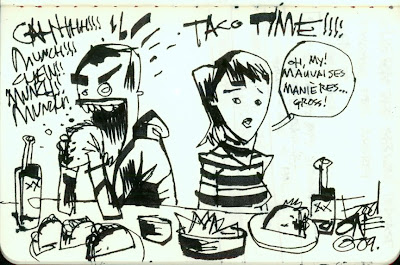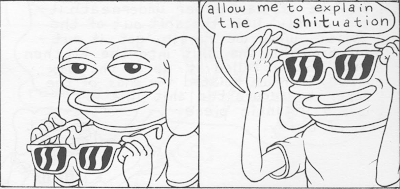 So, I thought about putting up a kind of obnoxious message about how the “New Year’s resolution” for everybody reading and writing about rap on the internets should be some attempt to at least like, foster discussion?
So, I thought about putting up a kind of obnoxious message about how the “New Year’s resolution” for everybody reading and writing about rap on the internets should be some attempt to at least like, foster discussion?
And then it seemed wiser to create something or another that might facilitate discussion instead of simply demanding it.
The result is gonna be a book club. All during the upcoming year, I’m going to read every novel by “street fiction” originator Donald Goines and at the end of each month (ideally, the final week day of whatever month it is), post some kind of fairly in-depth essay about each book. The comments section will ideally be a place for people to discuss the month’s book and if anyone wants to contribute more notable pieces about any of the books, they can do that too. They can be posted here or linked here, if you want to use your own blog to post your thoughts.
But real quick–some stuff about Goines: Was a pimp and a junkie, along with Iceberg Slim pretty much established Holloway House as a publisher and developed the current craze that is “street fiction”, was shot dead at his typewriter, is idolized by tons of rappers (personal fave lyrical reference here) and most importantly, is still kinda slept-on as an author of a whole bunch of deeply compelling work.
If you want to read-up on dude a bit more, do not, I repeat do not consult Eddie Stone’s Donald Writes No More. Do go find a cheap copy of Eddie B. Allen Jr.’s Low Road: The Life & Legacy of Donald Goines though, but only a cheap copy because even Allen’s book isn’t a masterpiece, but it does provide you with Goines’ life story and some terse but effective criticism of the novels. All Goines’ novels are relatively easy to find, relatively easy to read, and all will run you like $7 or $8 bucks new.
Below you’ll find a “syllabus” and after that, some quick notes on why the reading list is structured as it is.
- January: Dopefiend
- February: Whoreson
- March: Black Gangster
- April: Street Players
- May: White Man’s Justice, Black Man’s Grief
- June: Black Girl Lost
- July: Eldorado Red
- August: Swamp Man
- September: Never Die Alone
- October: Cry Revenge
- November: Daddy Cool
- December: “The Kenyatta Quadrilogy 1 & 2″ Crime Partners & Death List
- January: “The Kenyatta Quadrilogy 3 & 4″ Kenyatta’s Escape& Kenyatta’s Last Hit
This reading list primarily goes in the order his books were published. The most notable shift is moving Crime Partners, Death List, Kenyatta’s Escape, and Kenyatta’s Last Hit towards the end and all in order because they are essentially one big novel–and a long-ignored American epic in my opinion. I’ve dubbed them the “Kenyatta Quadrilogy” because that’s the guy that slowly becomes the main character and through which all of the action kinda sorta connects. Though these months, you’ll have to read two novels instead of one but it’s totally do-able. I read all four of them in a week.
Goines’ Inner City Hoodlum is omitted from this list because it’s up-for-debate as to how much he actually had to do with it. It was finished by another author after Goines’ death and well, you can tell. That book will be used as a kind of February “coda” for the Year of Goines Book Club, a way to identify Goines’ style and structuring through its rather apparent absence in that particular book.
Yeah, get reading! Any questions or suggestions on how to run this can be put in the comments section.
 “Confederate flags, I see em’ on the truck with the windows down/Why’s he playing Beanie Sigel?/Cause his daddy was a dopeman./Lynrd Skynrd didn’t talk about movin’ keys of coke, man/Ain’t no such thing as a free bird…”
“Confederate flags, I see em’ on the truck with the windows down/Why’s he playing Beanie Sigel?/Cause his daddy was a dopeman./Lynrd Skynrd didn’t talk about movin’ keys of coke, man/Ain’t no such thing as a free bird…”
 One more thing. Actual blog content is soon to come. I wrote about Matteo Garrone’s Gomorrah for the Baltimore City Paper’s “Year in Film”, it was ranked #2, right after Revanche, whatever that is…
One more thing. Actual blog content is soon to come. I wrote about Matteo Garrone’s Gomorrah for the Baltimore City Paper’s “Year in Film”, it was ranked #2, right after Revanche, whatever that is… The reason this blog was relatively silent about G-Side’s masterful Huntsville International was because of this article in this week’s Village Voice about G-Side, the new mixtape, and their connection to East Village Radio’s very awesome “Baller’s Eve”. In the process of doing the article, I managed to lose my driver’s license, spill Crystal Light all over my Macbook, hang-out in New York with G-Side and The Baller’s Eve dudes, as well as meet Joseph of “Geek Down” and yes, the Internets Celebrities Rafi and Dallas. Loads of fun. On the way back to Baltimore, I listened to Huntsville International for the first time and it just totally devastated me. I hope I was able to put some of that experience into words.
The reason this blog was relatively silent about G-Side’s masterful Huntsville International was because of this article in this week’s Village Voice about G-Side, the new mixtape, and their connection to East Village Radio’s very awesome “Baller’s Eve”. In the process of doing the article, I managed to lose my driver’s license, spill Crystal Light all over my Macbook, hang-out in New York with G-Side and The Baller’s Eve dudes, as well as meet Joseph of “Geek Down” and yes, the Internets Celebrities Rafi and Dallas. Loads of fun. On the way back to Baltimore, I listened to Huntsville International for the first time and it just totally devastated me. I hope I was able to put some of that experience into words. So there’s a pretty nutty thing I wrote about Diplo’s loathsome “Free Gucci” T-shirt and upcoming mixtape up on the Voice’s “Sound of the City” blog. Word to Zach Baron for sculpting it all into something that sorta makes sense:
So there’s a pretty nutty thing I wrote about Diplo’s loathsome “Free Gucci” T-shirt and upcoming mixtape up on the Voice’s “Sound of the City” blog. Word to Zach Baron for sculpting it all into something that sorta makes sense:
 Comments have been disabled so this doesn’t seem like some kind of back-patting party or something. Finally held the new XXL in my hands and read the very kind comments on my blog (“Better known as No Trivia, Soderberg’s blog gives rap the kind of intellectual, analytical respect is deserves.”) and the other ninety-nine picks. It’s a different thrill than seeing my byline in-print and we’re all supposed to be too cool about this stuff, but damn, I’m honored.
Comments have been disabled so this doesn’t seem like some kind of back-patting party or something. Finally held the new XXL in my hands and read the very kind comments on my blog (“Better known as No Trivia, Soderberg’s blog gives rap the kind of intellectual, analytical respect is deserves.”) and the other ninety-nine picks. It’s a different thrill than seeing my byline in-print and we’re all supposed to be too cool about this stuff, but damn, I’m honored.